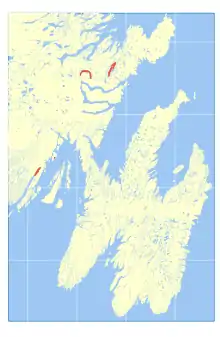Chamberlain's Brook Formation
The Chamberlain's Brook Formation is a thin but distinctive geologic formation of dark red calcareous mudstones[3] that crops out from Rhode Island to Massachusetts and, Nova Scotia, New Brunswick and Newfoundland.[2] It preserves fossils, including trilobites, dating back to the lower mid-Cambrian period.[2] Its lowermost member is the Braintree Member (lowest Middle Cambrian) and the uppermost member is the Fossil Brook Member.[2]
| Chamberlain's Brook Formation Stratigraphic range: Middle Cambrian ~509–506 Ma | |
|---|---|
| Type | Formation |
| Unit of | Adeyton Group[1] |
| Sub-units | Fossil Brook Member (and others) |
| Underlies | Manuels River Formation (unconformably?)[2] |
| Thickness | up to 14 m (46 ft)[2] |
| Lithology | |
| Primary | Green, purple and red siliciclastic marine mudstones[2] |
| Location | |
| Region | Atlantic coast |
| Country | |
 Occurrence of the Chamberlain's Brook Formation in southeastern Newfoundland | |
References
- Terrence Patrick Fletcher (2006). Bedrock Geology of the Cap St. Mary's Peninsula. Southwest Avalon Peninsula, Newfoundland (PDF). St. John's Newfoundland: Department of Natural Resources Geological Survey Newfoundland Labrador. ISBN 1-55146-031-9.
- Kim, Dong HEE; Westrop, Stephen R.; Landing, ED (2002). "Middle Cambrian (Acadian Series) Conocoryphid and Paradoxidid Trilobites from the Upper Chamberlain's Brook Formation, Newfoundland and New Brunswick". Journal of Paleontology. 76 (5): 822. doi:10.1666/0022-3360(2002)076<0822:MCASCA>2.0.CO;2.
- Normore, L. S. 2012: GEOLOGY OF THE RANDOM ISLAND MAP AREA (Nts 2C/04), Newfoundland. Current Research (2012) Newfoundland and Labrador Department of Natural Resources Geological Survey Report 12-:121–145.
- Various Contributors to the Paleobiology Database. "Fossilworks: Gateway to the Paleobiology Database". Archived from the original on 31 July 2014. Retrieved 30 June 2014.
This article is issued from Wikipedia. The text is licensed under Creative Commons - Attribution - Sharealike. Additional terms may apply for the media files.